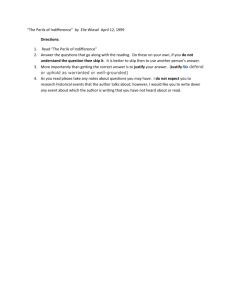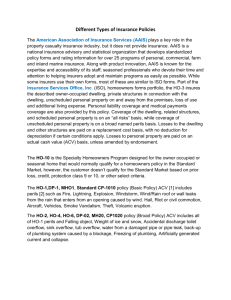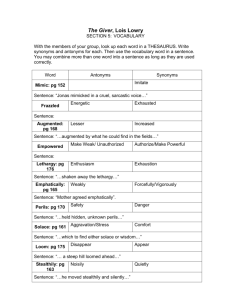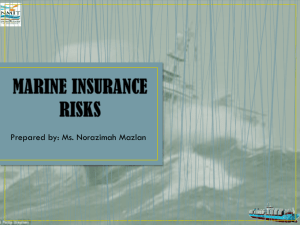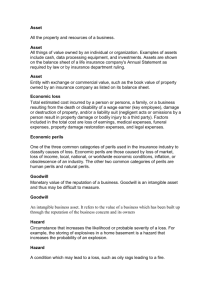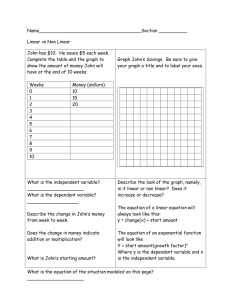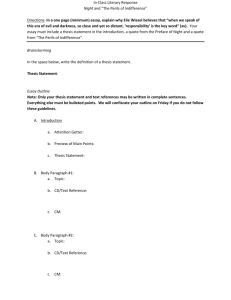This is how to install the Installation Template as your default template
advertisement
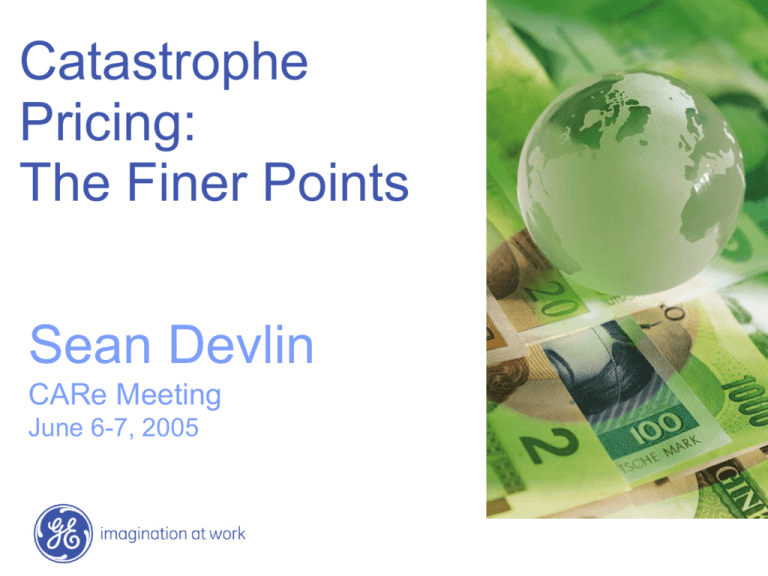
Catastrophe Pricing: The Finer Points Sean Devlin CARe Meeting June 6-7, 2005 Agenda Vendor Modeling Process Evaluating Inputs Unmodeled Perils Evaluating Outputs Conversion of Loss Cost to Pricing 2 GE Insurance Solutions June 6-7, 2005 Vendor Models –What to Use? Major modeling firms AIR EQE RMS Other models, including proprietary Options in using the models Use one model exclusively Use one model by “territory” Use multiple models for each account 3 GE Insurance Solutions June 6-7, 2005 Vendor Models –What to Use? (Cont’d) Use One Model Exclusively Benefits Simplify process for each deal Consistency of rating Lower cost of license Accumulation easier Running one model for each deal involves less time Drawbacks Can’t see differences by deal and in general Conversion of data to your model format 4 GE Insurance Solutions June 6-7, 2005 Vendor Models –What to Use? (Cont’d) Use One Model By “Territory” Detailed review of each model by “territory” Territory examples (EU wind, CA EQ, FL wind) Select adjustment factors for the chosen model Benefits Simplify process for each deal Consistency of rating Accumulation easier Running one model involves less time Drawbacks Can’t see differences by deal Conversion of data to your model format 5 GE Insurance Solutions June 6-7, 2005 Vendor Models –What to Use? (Cont’d) Use Multiple Models Benefits Can see differences by deal and in general Drawbacks Consistency of rating? Conversion of data to each model format Simplify process for each deal High cost of licenses Accumulation difficult Running one model for each deal is time consuming 6 GE Insurance Solutions June 6-7, 2005 Model Inputs Garbage In => Garbage Out TIV checks/ aggregates “As-if” past events Scope of data (e.g. RMS – WS, EQ, TO datasets) Which “territory” modeled and not modeled Type of country considered for exposures abroad Clash between separate zones (US – Caribbean) Tier I – well established models – US, EU, etc. Tier II – modeled, but less reliable – SA, Caribbean Tier III – not modeled 7 GE Insurance Solutions June 6-7, 2005 “Unmodeled” Perils Winter storm Not insignificant peril in some areas, esp. low layers 1993: 1.75B – 14th largest 1994: 100M, 175M, 800M, 105M 1996: 600M, 110M, 90M, 395M 2003: 1.6B # of occurrences in a cluster????? Possible Understatement of PCS data Methodology Degree considered in models Evaluate past event return period(s) Adjust loss for today’s exposure Fit curve to events 8 GE Insurance Solutions June 6-7, 2005 “Unmodeled” Perils (cont’d) Flood Less frequent Development of land should increase frequency Methodology Degree considered in models Evaluate past event return period(s),if possible No loss history – not necessarily no exposure Terrorism Modeled by vendor model? Scope? Adjustments needed Take-up rate – current/future Future of TRIA – exposure in 2006 Other – depends on data 9 GE Insurance Solutions June 6-7, 2005 “Unmodeled” Perils (cont’d) Wildfire Not just CA Oakland Fires: 1.7B – 15th largest Development of land should increase freq/severity Two main loss drivers Brush clearance – mandated by code Roof type (wood shake vs. tiled) Methodology Degree considered in models Evaluate past event return period(s), if possible Risk management, esp. changes No loss history – not necessarily no exposure 10 GE Insurance Solutions June 6-7, 2005 “Unmodeled” Perils (cont’d) Fire Following No EQ coverage = No loss potential? NO!!!!! Model reflective of FF exposure on EQ policies? Severity adjustment of event needed, if Some policies are EQ, some are FF only Only EQ was modeled Methodology Degree considered in models Compare to peer companies for FF only Default Loadings for unmodeled FF Multiplicative Loadings on EQ runs 11 GE Insurance Solutions June 6-7, 2005 “Unmodeled” Perils (cont’d) Extratropical wind National writers tend not to include TO exposures Models are improving, but not quite there yet Significant exposure Frequency: TX Severity: May 2003 event of 10B – 9th largest Methodology Experience and exposure Rate Compare to peer companies with more data Compare experience data to ISO wind history Weight methods 12 GE Insurance Solutions June 6-7, 2005 “Unmodeled” Perils (cont’d) No Data Typically for per risk contracts without detailed data Typically not a loss driver on per risk treaties However, exceptions exist Methodology Experience and exposure Rate Compare to peer companies with modeling Develop default loads by layer/location 13 GE Insurance Solutions June 6-7, 2005 “Unmodeled” Perils (cont’d) Other Perils Expected the unexpected – Dave Spiegler article Examples: Blackout caused unexpected losses Methodology Blanket load Exclusions, Named Perils in contract Develop default loads/methodology for an complete list of perils 14 GE Insurance Solutions June 6-7, 2005 Using the Output Don’t Trust the Black Box Data, Data, Data Contract Match: Definition of risk Definition occurrence Dual trigger contracts Scope of coverage Modeling of past exposures Need to convert to prospective period TIV inflation Change in exposures Know what assumptions were used by modeler 15 GE Insurance Solutions June 6-7, 2005 Loadings to final EL Considerations in final indicated “price” % of loss? % of s? Combination of above? Target LR, TR, CR? Reflect red zone capacity constraints? “Unused” capacity loads EL for Layer 100M x 100M is 5M EL for Layer 200M x 100M is 5.1M Loading for 100M x 200M?????? 16 GE Insurance Solutions June 6-7, 2005 Summary Determine process and models to use Know what was modeled Perform reasonability checks Understand strength and weakness of the models Add in the “unmodeled” exposure Make other adjustments to reflect ongoing terms and exposure Don’t Trust the Black Box 17 GE Insurance Solutions June 6-7, 2005
